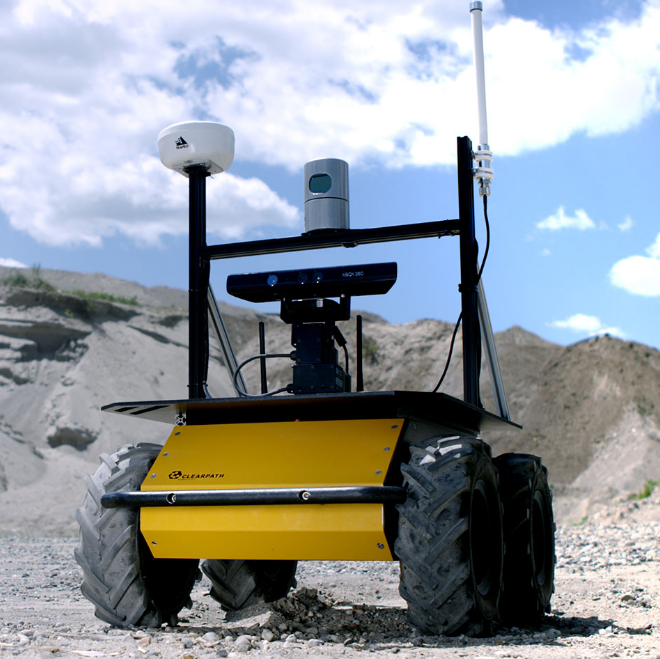先看这个匹配的原理
ceres中的类 BiCubicInterpolator
输入无限的二维grid1
2
3
4struct Grid2D {
enum { DATA_DIMENSION = 2 };
void GetValue(int row, int col, double* f) const;
};GetValue函数返回函数f(可能是向量)的值, 枚举DATA_DIMENSION表示所插值函数的维度,比如对一个图片(红绿蓝)进行插值,那么DATA_DIMENSION = 3
BiCubicInterpolator使用三次卷积算法生成平滑估计,或者说双三次插值法,用来在真实曲线的任一点评价
对二维数组进行插值1
2
3
4
5
6
7
8const double data[] = {1.0, 3.0, -1.0, 4.0,
3.6, 2.1, 4.2, 2.0,
2.0, 1.0, 3.1, 5.2};
// 生成 BiCubicInterpolator 需要的二维数组
Grid2D<double, 1> array(data, 0, 3, 0, 4);
BiCubicInterpolator interpolator(array);
double f, dfdr, dfdc;
interpolator.Evaluate(1.2, 2.5, &f, &dfdr, &dfdc);
函数void Evaluate(double r, double c, double* f, double* dfdr, double* dfdc),残差会对应第3个参数f。 Evaluate the interpolated function value and/or its 导数. Returns false 如果r 或者 c越界
OccupiedSpaceCostFunction2D
这个Occupied Space Cost Function的模型和 Real time correlative scan matching 的思路基本上一致,只是求解方法变成了最小二乘问题的求解。
将点云中所有点的坐标映射到栅格坐标系, 假如点对应的空闲概率最小,说明对应栅格几乎被占据,点确实是hit点,此时的变换为最优变换。 出于精度考虑使用了ceres提供的双三线性插值。 还有地图大小限制的问题,即一旦点云变换后存在部分脱离地图范围的点,这些点的代价值需要定义。cartographer中的做法是在地图周围增加一个巨大的边框(kPadding),并且通过一个地图适配器定义点落在边框中的代价值。
先看创建代价函数 CreateOccupiedSpaceCostFunction2D1
2
3
4
5
6
7
8
9
10
11
12
13
14
15
16// 创建代价函数 for matching the 'point_cloud' to the 'grid' with a 'pose'
// 'point_cloud' 是 filtered_gravity_aligned_point_cloud
// 'grid' 是 matching_submap->grid()
// grid 和 point observation 匹配越差,代价越大
// 比如 points falling into less occupied space
ceres::CostFunction* CreateOccupiedSpaceCostFunction2D(
const double scaling_factor, const sensor::PointCloud& point_cloud,
const Grid2D& grid)
{
return new ceres::AutoDiffCostFunction<OccupiedSpaceCostFunction2D,
ceres::DYNAMIC, /* residuals 残差维度未知 */
3 /* pose variables */>
(
new OccupiedSpaceCostFunction2D(scaling_factor, point_cloud, grid),
point_cloud.size() );
}OccupiedSpaceCostFunction2D的构造函数只有参数赋值
1 | template <typename T> |
占用栅格中原本存储的就是栅格空闲的概率,而这里GetValue查询出来的概率其实就是 ,令其最小化就对了
GridArrayAdapter是cartographer定义的,使用适配器模式,interpolator构造函数的参数需要的是模板里的类型。重要函数的是GetValue,调用的地方在interpolator.Evaluate里面。根源还是BiCubicInterpolator1
2
3
4
5
6
7
8
9
10
11
12
13
14
15
16
17
18
19
20
21
22
23
24
25
26
27class GridArrayAdapter
{
public:
enum { DATA_DIMENSION = 1 }; //被插值的向量维度
explicit GridArrayAdapter(const Grid2D& grid) : grid_(grid) {}
// 返回空闲概率, kPadding 是个很大的数
void GetValue(const int row, const int column, double* const value) const
{
// 处于地图外部时,赋予最大的free值
if(row < kPadding || column < kPadding ||
row >= NumRows() - kPadding || column >= NumCols() - kPadding)
*value = kMaxCorrespondenceCost;
// 在地图里取空闲概率,这里需要减掉kPadding,因为在传进来的时候,已经加了kPadding
else
*value = static_cast<double>(grid_.GetCorrespondenceCost(
Eigen::Array2i(column - kPadding, row - kPadding) ) );
}
int NumRows() const {
return grid_.limits().cell_limits().num_y_cells + 2 * kPadding;
}
int NumCols() const {
return grid_.limits().cell_limits().num_x_cells + 2 * kPadding;
}
private:
const Grid2D& grid_;
}
